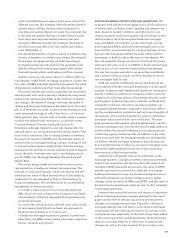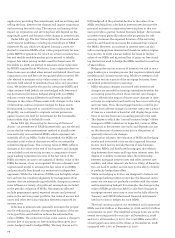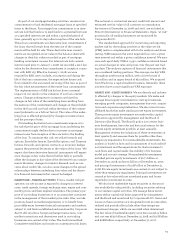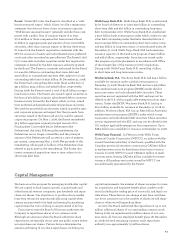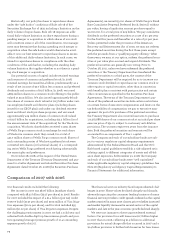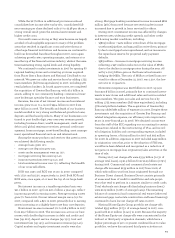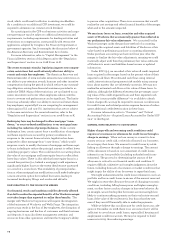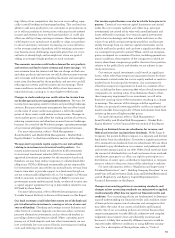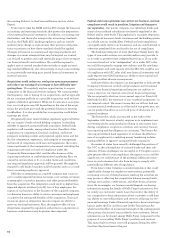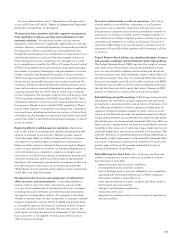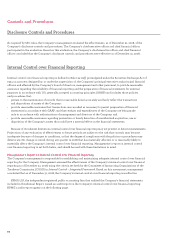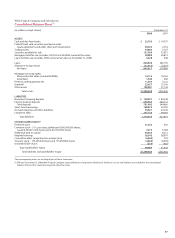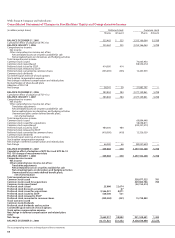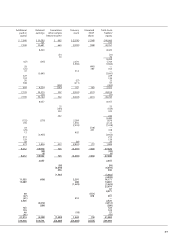Wells Fargo 2008 Annual Report Download - page 81
Download and view the complete annual report
Please find page 81 of the 2008 Wells Fargo annual report below. You can navigate through the pages in the report by either clicking on the pages listed below, or by using the keyword search tool below to find specific information within the annual report.For more information, refer to “Critical Accounting Policies –
Allowance for Credit Losses” and “Risk Management – Credit
Risk Management Process” in the Financial Review section of
this Report.
We may have more credit risk and higher credit losses to the
extent our loans are concentrated by loan type, industry seg-
ment, borrower type, or location of the borrower or collateral.
Our credit risk and credit losses can increase if our loans are
concentrated to borrowers engaged in the same or similar activi-
ties or to borrowers who as a group may be uniquely or dispro-
portionately affected by economic or market conditions. We
experienced the effect of concentration risk in 2007 and 2008
when we incurred greater than expected losses in our Home
Equity loan portfolio due to a housing slowdown and greater
than expected deterioration in residential real estate values in
many markets, including the Central Valley California market
and several Southern California metropolitan statistical areas.
As California is our largest banking state in terms of loans and
deposits, continued deterioration in real estate values and under-
lying economic conditions in those markets or elsewhere in
California could result in materially higher credit losses. As a
result of the Wachovia merger, we have increased our exposure
to California, as well as to Arizona and Florida, two states that
have also recently suffered significant declines in home values.
Continued deterioration in housing conditions and real estate
values in these states and generally across the country could
result in materially higher credit losses.
For more information, refer to “Risk Management – Credit Risk
Management Process – Loan Portfolio Concentrations” in the
Financial Review section of this Report and Note 6 (Loans and
Allowance for Credit Losses) to Financial Statements in this Report.
Loss of customer deposits and market illiquidity could increase
our funding costs. We rely on bank deposits to be a low cost and
stable source of funding for the loans we make. We compete with
banks and other financial services companies for deposits. If our
competitors raise the rates they pay on deposits our funding
costs may increase, either because we raise our rates to avoid
losing deposits or because we lose deposits and must rely on
more expensive sources of funding. Higher funding costs reduce
our net interest margin and net interest income. As discussed
above, the integration of Wells Fargo and Wachovia may result
in the loss of customer deposits.
We sell most of the mortgage loans we originate in order to
reduce our credit risk and provide funding for additional loans.
We rely on Fannie Mae and Freddie Mac to purchase loans that
meet their conforming loan requirements and on other capital
markets investors to purchase loans that do not meet those
requirements—referred to as “nonconforming” loans. Since 2007,
investor demand for nonconforming loans has fallen sharply,
increasing credit spreads and reducing the liquidity for those
loans. In response to the reduced liquidity in the capital markets,
we may retain more nonconforming loans. When we retain a loan
not only do we keep the credit risk of the loan but we also do not
receive any sale proceeds that could be used to generate new
loans. Continued lack of liquidity could limit our ability to fund—
and thus originate—new mortgage loans, reducing the fees we
earn from originating and servicing loans. In addition, we cannot
assure that Fannie Mae and Freddie Mac will not materially limit
their purchases of conforming loans due to capital constraints, or
changes in criteria for conforming loans (e.g., maximum loan
amount or borrower eligibility).
Changes in interest rates could reduce our net interest income
and earnings. Our net interest income is the interest we earn on
loans, debt securities and other assets we hold less the interest
we pay on our deposits, long-term and short-term debt, and other
liabilities. Net interest income is a measure of both our net interest
margin—the difference between the yield we earn on our assets
and the interest rate we pay for deposits and our other sources of
funding—and the amount of earning assets we hold. Changes in
either our net interest margin or the amount of earning assets we
hold could affect our net interest income and our earnings.
Changes in interest rates can affect our net interest margin.
Although the yield we earn on our assets and our funding costs
tend to move in the same direction in response to changes in
interest rates, one can rise or fall faster than the other, causing
our net interest margin to expand or contract. Our liabilities tend
to be shorter in duration than our assets, so they may adjust
faster in response to changes in interest rates. When interest
rates rise, our funding costs may rise faster than the yield we
earn on our assets, causing our net interest margin to contract
until the yield catches up.
Changes in the slope of the “yield curve”—or the spread
between short-term and long-term interest rates—could also
reduce our net interest margin. Normally, the yield curve is
upward sloping, meaning short-term rates are lower than long-
term rates. Because our liabilities tend to be shorter in duration
than our assets, when the yield curve flattens or even inverts, we
could experience pressure on our net interest margin as our cost
of funds increases relative to the yield we can earn on our assets.
The interest we earn on our loans may be tied to U.S.-denomi-
nated interest rates such as the federal funds rate while the inter-
est we pay on our debt may be based on international rates such
as LIBOR. If the federal funds rate were to fall without a corre-
sponding decrease in LIBOR, we might earn less on our loans
without any offsetting decrease in our funding costs. This could
lower our net interest margin and our net interest income.
We assess our interest rate risk by estimating the effect on
our earnings under various scenarios that differ based on
assumptions about the direction, magnitude and speed of inter-
est rate changes and the slope of the yield curve. We hedge some
of that interest rate risk with interest rate derivatives. We also
rely on the “natural hedge” that our mortgage loan originations
and servicing rights can provide.
We do not hedge all of our interest rate risk. There is always
the risk that changes in interest rates could reduce our net inter-
est income and our earnings in material amounts, especially if
actual conditions turn out to be materially different than what we
assumed. For example, if interest rates rise or fall faster than we
assumed or the slope of the yield curve changes, we may incur
significant losses on debt securities we hold as investments. To
reduce our interest rate risk, we may rebalance our investment
and loan portfolios, refinance our debt and take other strategic
actions. We may incur losses when we take such actions.
For more information, refer to “Risk Management – Asset/
Liability and Market Risk Management – Interest Rate Risk” in
the Financial Review section of this Report.


